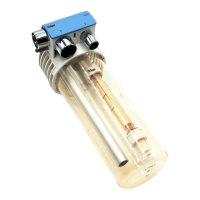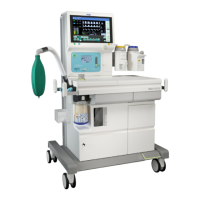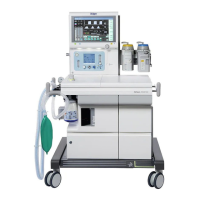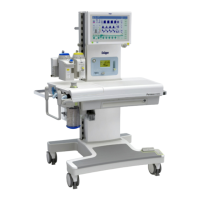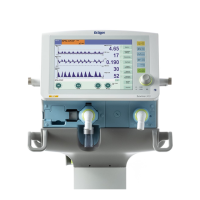Chapter 7 - Ventilation When Changing Between Ventilation Modes
100 Apollo Operator’s Manual
Part Number: 90 38 237, 6th edition
When Changing Between
Ventilation Modes
When changing to a different ventilation mode, the
presettings are adopted or appropriately derived from
the parameters of the preceding mode. Presettings
that are identical in both ventilation modes are
adopted directly (e.g., Freq, T
INSP, ∆PPS, Trigger).
When changing from volume-controlled to
pressure-controlled ventilation, the measured
plateau pressure is adopted as the new value for
P
INSP. If a valid plateau pressure value is not
available, the last value used in the case will be used
as the preset value (the preset value of P
INSP will be
at least PEEP + 5)
. The PAW low alarm limit will be
pre-set to P
INSP-2 if the alarm limit was higher than
P
INSP-2 during volume-controlled ventilation.
When changing from pressure-controlled to
volume-controlled ventilation, the new tidal
volume (V
T) is adopted from the measured minute
volume (MV) and the set frequency (Freq). Only the
minute volume applied by the ventilator is taken into
account; pressure-supported breathing strokes by
the patient are disregarded.
When changing from automatic ventilation
modes to the optional pressure-support mode,
the set PEEP, ∆P
PS, and trigger values are adopted.
If
∆PPS and/or trigger were set to “OFF”, the last
values used are adopted in pressure support mode.
In all other cases the configured default settings are
used. The PAW low alarm limit will be pre-set to
PEEP+∆P
PS-2 if the alarm limit was higher than
PEEP+∆P
PS-2 during automatic ventilation mode.
When changing from the optional pressure-
support mode to automatic ventilation modes,
the set PEEP, ∆P
PS, and trigger values are adopted.
The last values that were set are used for the other
parameters and the configured default settings in all
other cases.
Automatic Parameter Changes
With the proper configuration setting in the Standby
Configuration screen, certain ventilation parameters
change automatically when a related parameter is
changed. See the “Configuration” chapter for
complete information.
TINSP Changes
TSLOPE may be reduced simultaneously if TINSP is
reduced.
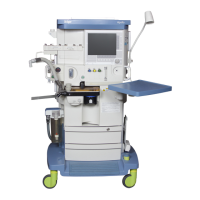
